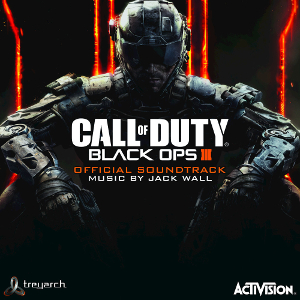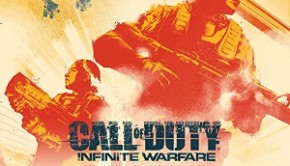Call of Duty -Black Ops III- Soundtrack
 |
Album Title: Call of Duty -Black Ops III- Soundtrack |
| Record Label: N/A |
|
| Catalog No.: N/A |
|
| Release Date: November 6, 2015 |
|
| Purchase: Download at iTunes |
Overview
Call of Duty: Black Ops III is primarily scored by composer Jack Wall, with some contributions by in-house Treyarch composer Brian Tuey. Wall, who has composed for the Black Ops II score and the Mass Effect series, used a myriad of styles to create a score with influences from several different veins of modern music and mixing. From rock orchestra to jazzy lounge bands to electronics and ambiance, the music of Black Ops III brings a range of sounds to the latest installment of the popular first-person shooter series.
Body
The album opens with “I Live,” a track actually written by Brian Tuey instead of Jack Wall. It sets the tone for the album rather well, as it’s one of the many ambient tracks of the score. There is movement in the track, but slow movement, as Tuey takes his time in building up a steady crescendo of sounds, from foreign unrecognizable sounds to a distinct melody. An orchestral version by Jack Wall surfaces later appears on the album, and opens immediately with the melody. In this setting, it sounds less alien and more heroic. I wasn’t expecting to enjoy the theme as much as I did from the opening track, but Wall includes a carefully orchestrated choir and countermelody that really builds up the anticipation in the track.
The base technique used seems to be ambient tracks, but the score is heavily peppered with orchestral works and strange genres from all sorts of settings and time periods. The second track, “Frozen Forest” is one example of the ambient tracks that seem to grind the action, and movement, of the album to a halt. Admittedly, “Frozen Forest” does have a melody, which is soon joined by an electronic percussion of some kind. “Safehouse” pits the ambience against a light, synth-plucked motif that keeps up a gentle pace. Tuey seems to have an ability for adding movement to ambient pieces, which really adds a lot to what could be rather dull portions of the score. “Ignition” in particular is another light, electronic track featuring only two chords, but the artist does enough with them to make them engaging. The piece has a crescendo form, with the intensity slowly building from beginning to end. In the middle, the sound falls away slightly but is replaced by a new percussive rhythm that gives the piece more stability. The piece is very free-form.
On the whole, Black Ops III is a difficult score to talk about because of its serious diversity of track styles. “Ego Vivo” utilizes an ecclesiastical female choir, beautiful melodies with lengthy whole notes between phrases. Soon a male chorus joins them to fill out all the voice parts. The effect is gorgeous and glossy, but is soon followed by the track “Sand Castle,” a gritty piece with Western undertones. A low guitar holds out an ostinato at the beginning, and when a string melody picks up, it unabashedly follows an ominous scale pattern. The percussion grows heavier as the melody jumps up in octave, and a slow countermelody begins in the octave the original melody left empty. The piece is action-packed, moving from dusty cowboy to modern adventurer in a matter of minutes, and fell on the more colorful side of the soundtrack.
“Ramses Station” is a buzzing and burbling track with lots of action in the bass but not much above that. Although it certainly has a constant movement, it doesn’t particularly go anywhere, mostly serving as a stationary action track. One of my favorite tracks on the album is “Liberty Road”, which sounds like an anthem, although not one from the Western side of the Atlantic. It’s driven, fast-paced, and kind of dark, which made it stand out on the album as being particularly animated. “Diaz” brings in a slow, stately melody, marked regularly with drums. The somber piece uses heavy choir in unison with strings or brass for another very dark effect; halfway through the march pattern fades away for a more widespread orchestral motif.
One of the major themes on the album is surprisingly bright and fresh, at least in its opening notes. Appearing in “New World / From the Brink of Death,” the theme is accompanied by an atmospheric synth note that lasts throughout the melody, played on strings. It’s in a higher register than many of the similarly styled tracks on the album, which gives it a unique shine. The second part of the piece uses drums to emulate a heartbeat, and ends with a soulful slew of vocals. The first theme returns in “Therapy,” this time without the migration to the second piece, and with a more lasting synth note. The contrast between the synth note and the strings is not an original one, but it is effective in suggesting an emotional auditory experience for the listener.
“Leviathan” features a strange combination of styles, from soli strings to full orchestra to rock guitar and drums, and a choir that sings an eerie melody as the piece crescendos. The intensity of the piece towards the end is dramatic and quite enjoyable, and the following track, “I Live (Orchestral Version)” only adds to that mood, repeating the melody from the first track with the same chorus-and-strings combination that Wall utilizes all the way back at the beginning of the album with “Prologue / Black Ops,” a bright string-heavy rendition of the game’s main theme.
One of the closing tracks, “Cold Hard Cash” is a lengthier track that features singer Antonia Bennett in a warm lounge setting. Bennett’s voice is sweet and relaxed, sporting a gentle vibrato and casually swinging through the notes. Backed by a lounge-style band, the brassy accompaniment complements her clear voice, and the resulting piece feels close-up and engaging in a way that the rest of the soundtrack really doesn’t. Following Bennett, the last few tracks run through a variety of styles, most of them clocking on or just under a minute in length. Most of them are short, jazzy snippets with mild leanings towards specific genres; “Speed Cola” has a heavy Latin vibe that packs the short piece with flavor, and the vocals of “Widow’s Wine” are heavily filtered against the brass instrumentation.
Summary
While the soundtrack wasn’t as engaging as Black Ops II, particularly with the slews of electronic action-oriented soundscapes (for lack of a better phrase), the range of music on the soundtrack helped its cause overall. At some points, the game itself was hard to pin down in the mix of music; I don’t know that the combination of orchestra, electronics, synth, and ambiance worked as a musical unit in the score. Adding the other styles on top didn’t help that cause. But, on the other hand, there is at least something for everyone in this score, however small that something may be. The digital soundtrack was available with the Juggernog edition and can also be separately purchased at various online music stores.
Do you agree with the review and score? Let us know in the comments below!
3.5
Posted on December 8, 2015 by Emily McMillan. Last modified on December 8, 2015.













